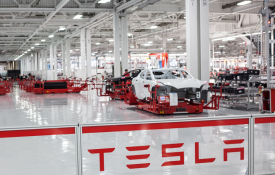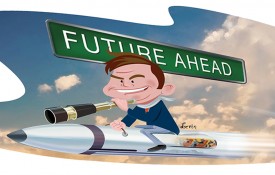Los Angeles faces a defining moment in its history. As the national economy begins to turn the corner, I am focused not just on putting the recession in the rearview mirror but on building the economy of the future right here in LA.
I am blessed to lead a city that already has some incredible advantages: our weather, geography, and people, just for starters. But today, Los Angeles also benefits from our position at the convergence between technology and content; what we call the tech industry is today as much about content as it is about software and hardware. People aren’t just looking to technology to find tools for more efficient commerce, more powerful learning, and more meaningful relationships; they are looking to technology to connect them to the stories, fashion, music, and images that move them.

Mayor Garcetti and Eli Broad visit The Broad Museum during construction
Los Angeles is the global leader in content creation – raising and attracting the best creators in the world, from engineers to designers, composers to directors. And we have the most entrepreneurial population in the United States if not the world.
The challenge we face is whether startups and Big Tech will continue to call Los Angeles home or whether this confluence of tech and content will eventually call someplace else home.
As Mayor, I’m leading a “back to basics” agenda that I believe will retain, grow, and attract cutting edge ideas, entrepreneurs, and companies. Part of this agenda is focused on economic development. Based on my experience in cutting the city’s business tax for tech firms, new businesses, and small businesses, I have developed a plan to entirely phase out this tax – a gross receipts tax that taxes companies even when they lose money and which gives L.A. the dubious honor of being home to the highest business tax in the county.
I’ve also mandated that our departments end the bureaucratic status quo. The same old way of doing things at City Hall – where the goal is to find a way to say “no” as opposed to problem solving to get to “yes” – is over. So-called red tape should be there to protect residents and businesses – not stop innovation and growth.
I believe City Hall needs a culture more interested in outcomes than in process. I would guess that most CEOs don’t measure
success by how many forms are completed. We judge success based on results – in my case, by how many jobs were created; how much faster people were served; and how many taxpayer dollars were saved.
And we are using technology to hold ourselves accountable to these goals. At City Hall, we must practice what we preach about Los Angeles embodying a great tech future. I believe that attracting innovation requires us to promote and embody innovation in our own operations in city government.
My response is that I am delivering old-fashioned services in new-fangled ways. I do not seek technology for technology’s sake in city government. What I am seeking are the best tools available to solve Angelenos’ persistent problems—cutting down traffic, revitalizing our main streets, greening our neighborhoods, and keeping our communities safe.
I marked my 100th day in office by rolling out the first set of performance metrics against which I will track the performance of our managers now and moving forward. By posting these metrics online, I can hold departments accountable and Angelenos can hold me accountable at the same time.
So right now, if you visit lamayor.org/performance, you will see that I expect less use of imported water by our Department of Water and Power and lower greenhouse gas emissions from city government operations.
I’m seeking to change old budget practices here in L.A. by utilizing performance data to guide a shift to performance-based budgeting.
For too long, inertia has been the key driver of city department operations, as opposed to targets set by policymakers. We simply took last year’s allocation, continued last year’s programs, added or subtracted an arbitrary amount, and voila, we had the next year’s budget.
Through performance based budgeting, we will start our budgets every year from scratch and ask ourselves: what do we want to achieve and how do we get there?
What’s going to make or break Los Angeles as a technology leader is our basic infrastructure – whether the streets are safe, clean, and in good repair — and infrastructure that should be basic, like a robust fiber optic cable network. And after years of neglect here in Los Angeles, that requires a laser-like focus on the fundamentals.

Mayor Garcetti addressing constituents
Since taking office, some observers have asked me “How can you be focused on both a ‘Back to Basics’ and ‘High-Tech’ agenda at the same time? Aren’t they mutually exclusive?”
My response is that I am delivering old-fashioned services in new-fangled ways. I do not seek technology for technology’s sake in city government. What I am seeking are the best tools available to solve Angelenos’ persistent problems—cutting down traffic, revitalizing our main streets, greening our neighborhoods, and keeping our communities safe. In 2014, that often means a technological solution. Government too often tries to solve existing problems with existing tools, and that status-quo thinking simply doesn’t cut it.
The first app deployed here in Los Angeles was Garcetti311 (named by the developer, I assure you) which my Council office rolled out in 2010. At first glance, success seemed to be that there was a decent amount of buzz generated by the fact that our city now had a presence on the app store. But a closer look revealed something very basic: the app allowed people to report potholes for filling, graffiti for painting-over, and abandoned couches for removal. The 1.0 version of this service was to identify which of the city’s 35-plus departments was responsible for a service and track down the right number to call. Among other achievements, the app played a critical role in a more than 80 percent drop in graffiti in my district.
Los Angeles is poised to lead this country and the world as the global capital of collaboration, creativity, and innovation.
For over a decade, the city has had a “One Call to City Hall” 311 system, which works well, but now we have an electronic way for people to report problems anytime, anywhere, without hold times or call centers.
Along these same lines, I recently issued an executive directive to implement an Open Data policy and online platform. Beyond transparency, I believe this will lead to new solutions to problems and accelerate the innovation culture I’m seeking to grow in government. And I’m taking a cue from startups like Docstoc, Streetline, and Citysourced, and other firms who have launched new businesses based on government data.
These are the type of solutions that is at the core of my technology agenda for City Hall – which in turn represents the core of how we will put Los Angeles ahead of the competition for the jobs of tomorrow.
During the first decade of this century, cities like London, New York, and San Francisco rebounded after years of decline and went on to ascend to new heights. But these cities face limitations that Los Angeles doesn’t have. Some are choked by geography, which in turn has driven the cost of doing business to extreme levels. Bay Area residents are fed up with commuting from San Francisco to the suburbs in the Silicon Valley or vice versa, and there is a certain “company town” atmosphere that is setting in. L.A, on the other hand, is diverse in its geography, its planning, and its people – allowing business owners and their employees to live however they want right here. And our unique diversity creates an environment of cross-pollination that sustains us socially and inspires us in innovation.
Los Angeles is poised to lead this country and the world as the global capital of collaboration, creativity, and innovation. But this goal starts with local government embracing technology in its policies and practices—welcoming tech entrepreneurs, helping them find a well-trained workforce, and opening up City Hall as a platform for innovation and experimentation. The stakes are high—but given our historical track record of fearless re-imagination and the incredible human capital embodied in our people, I am confident that our best days are just ahead of us.















































